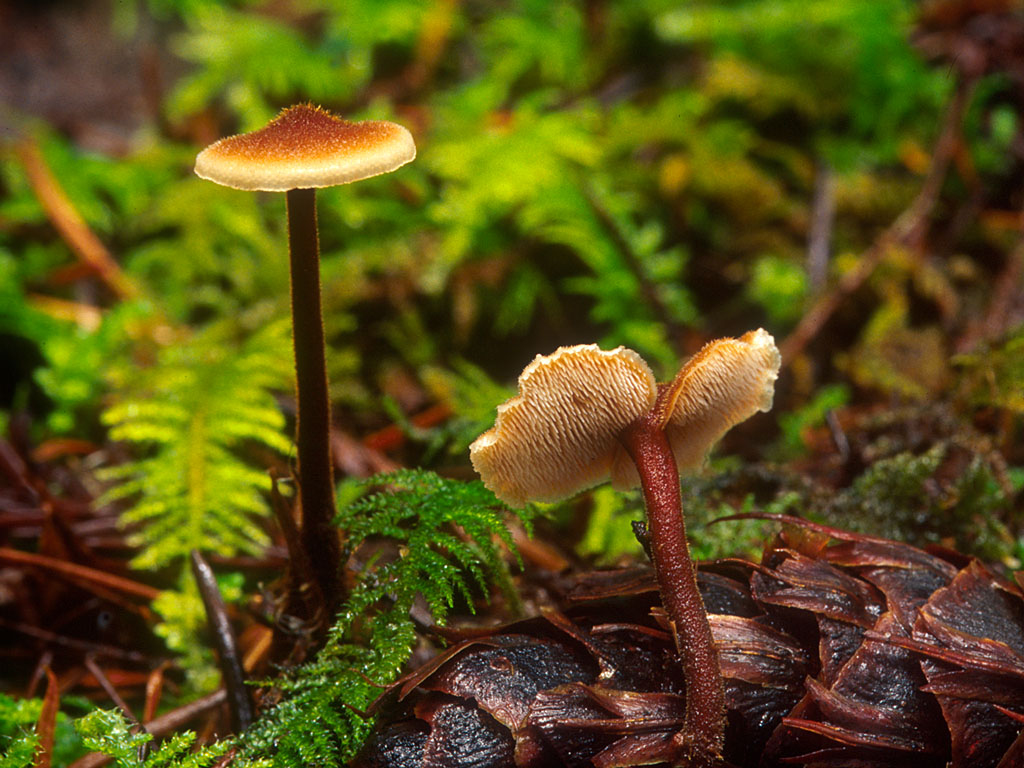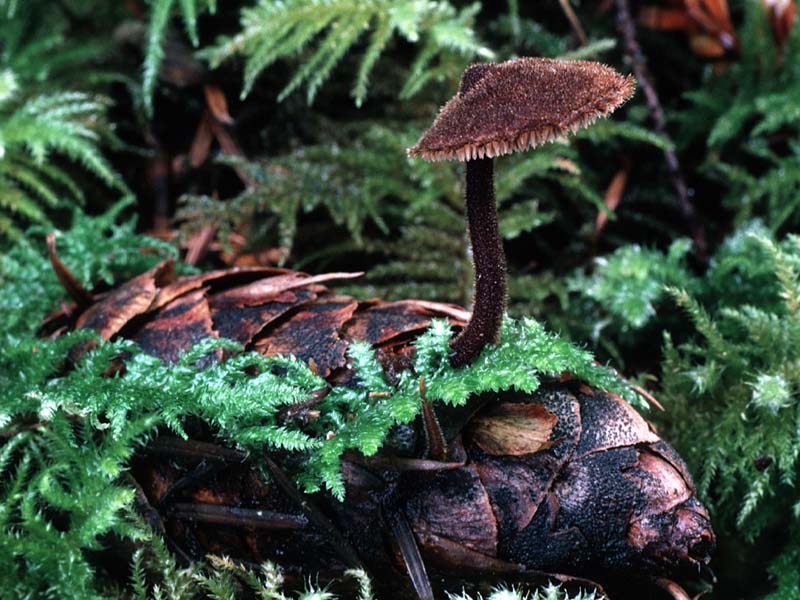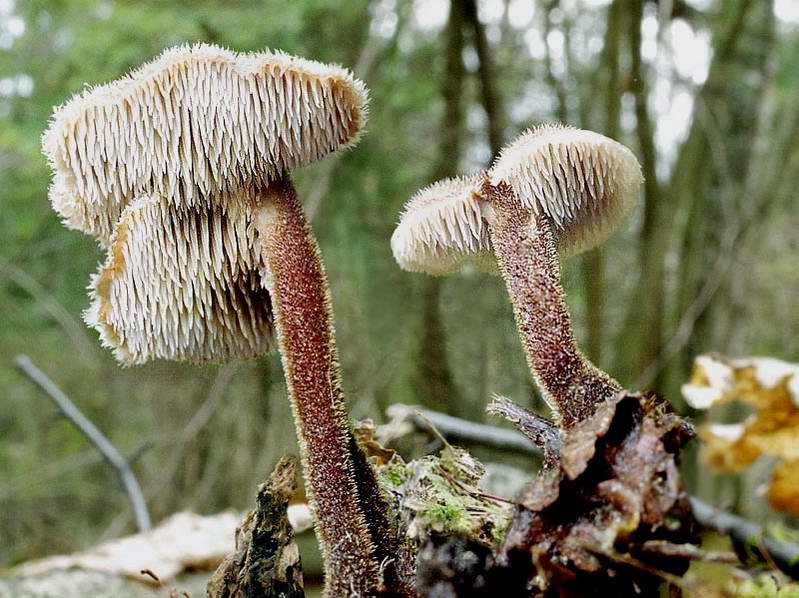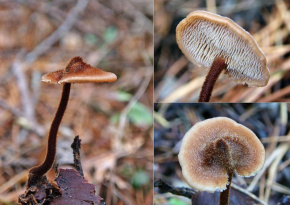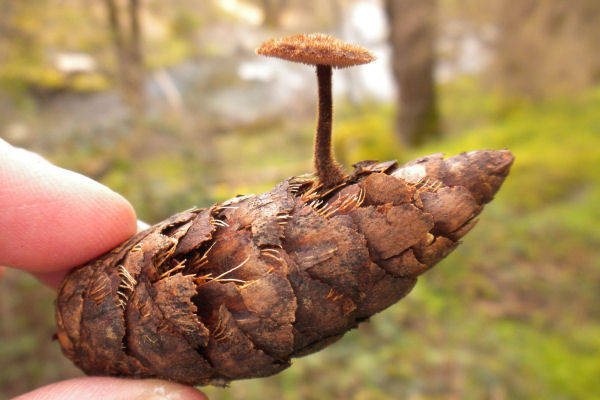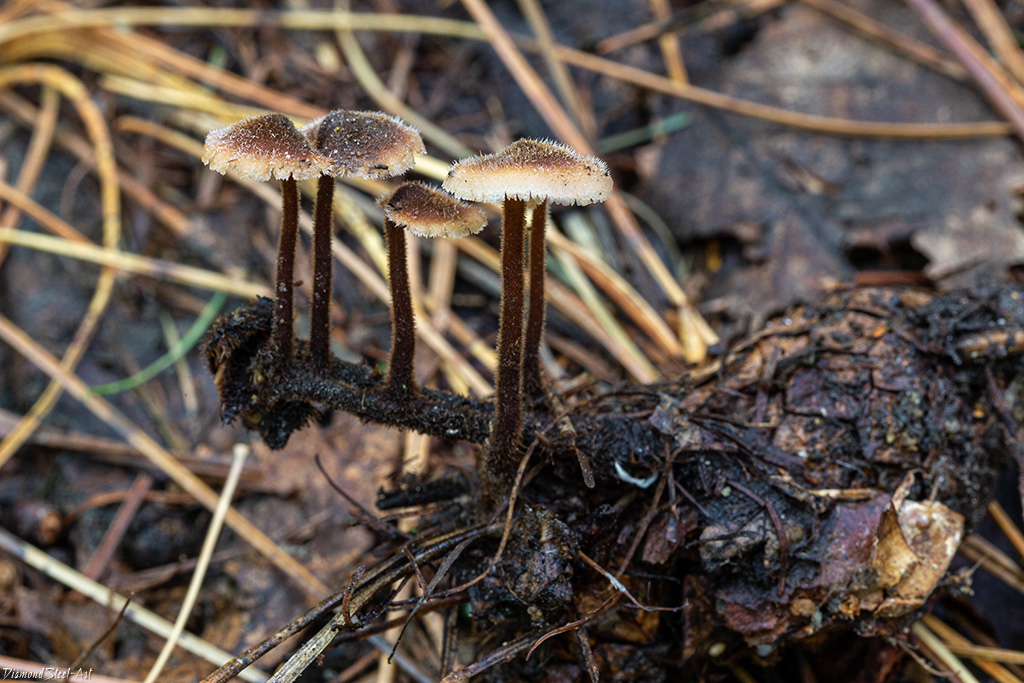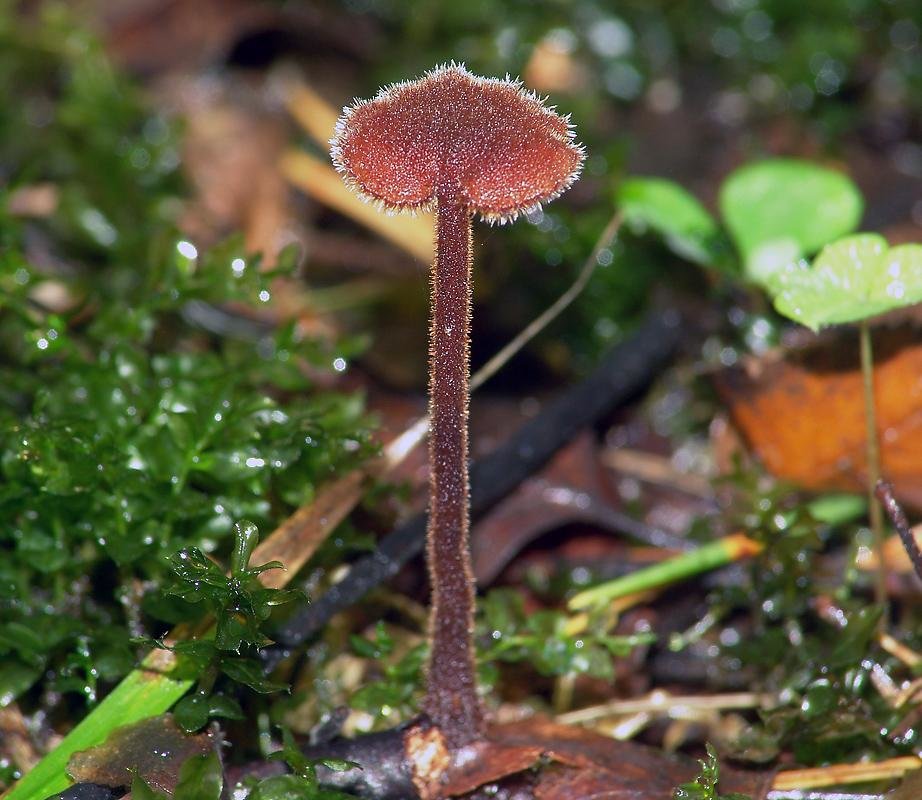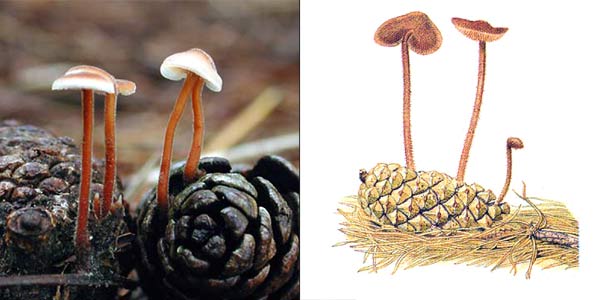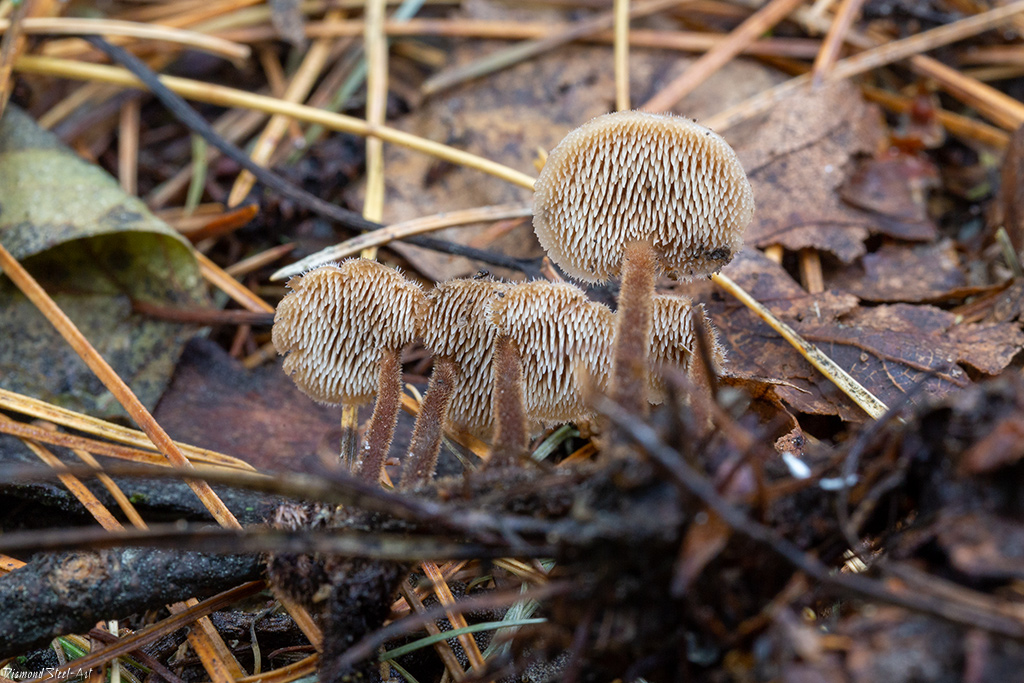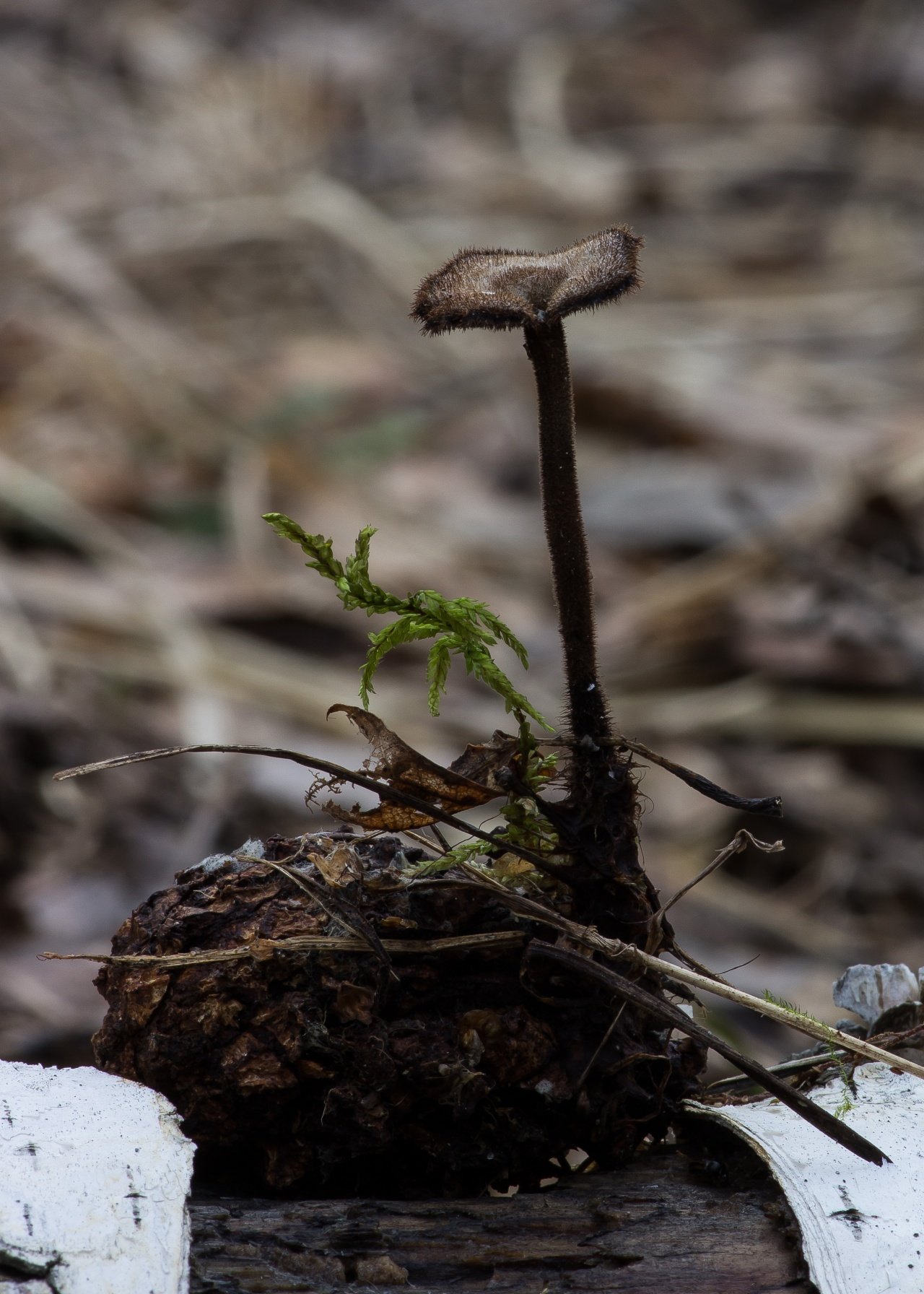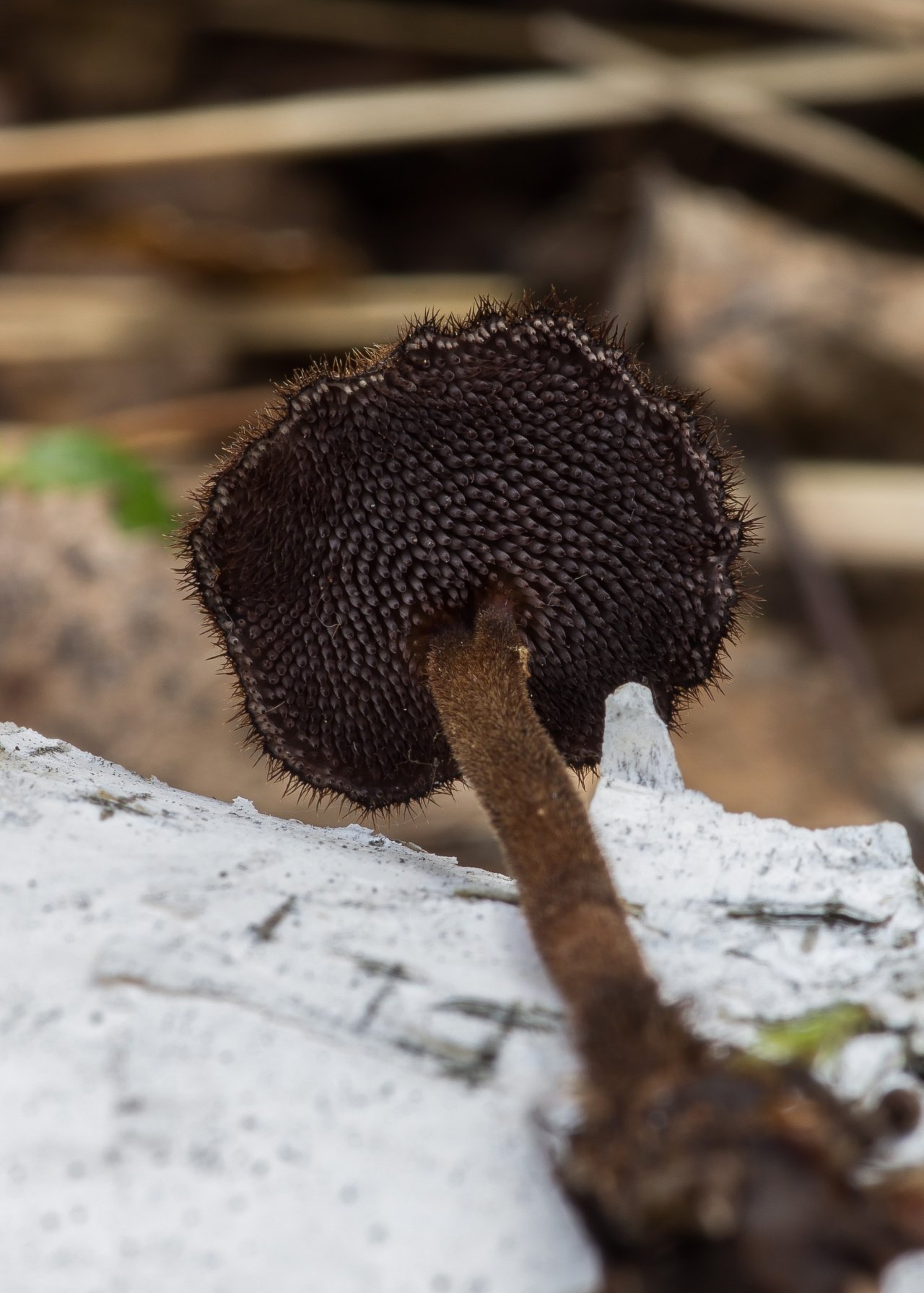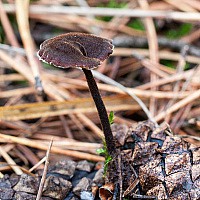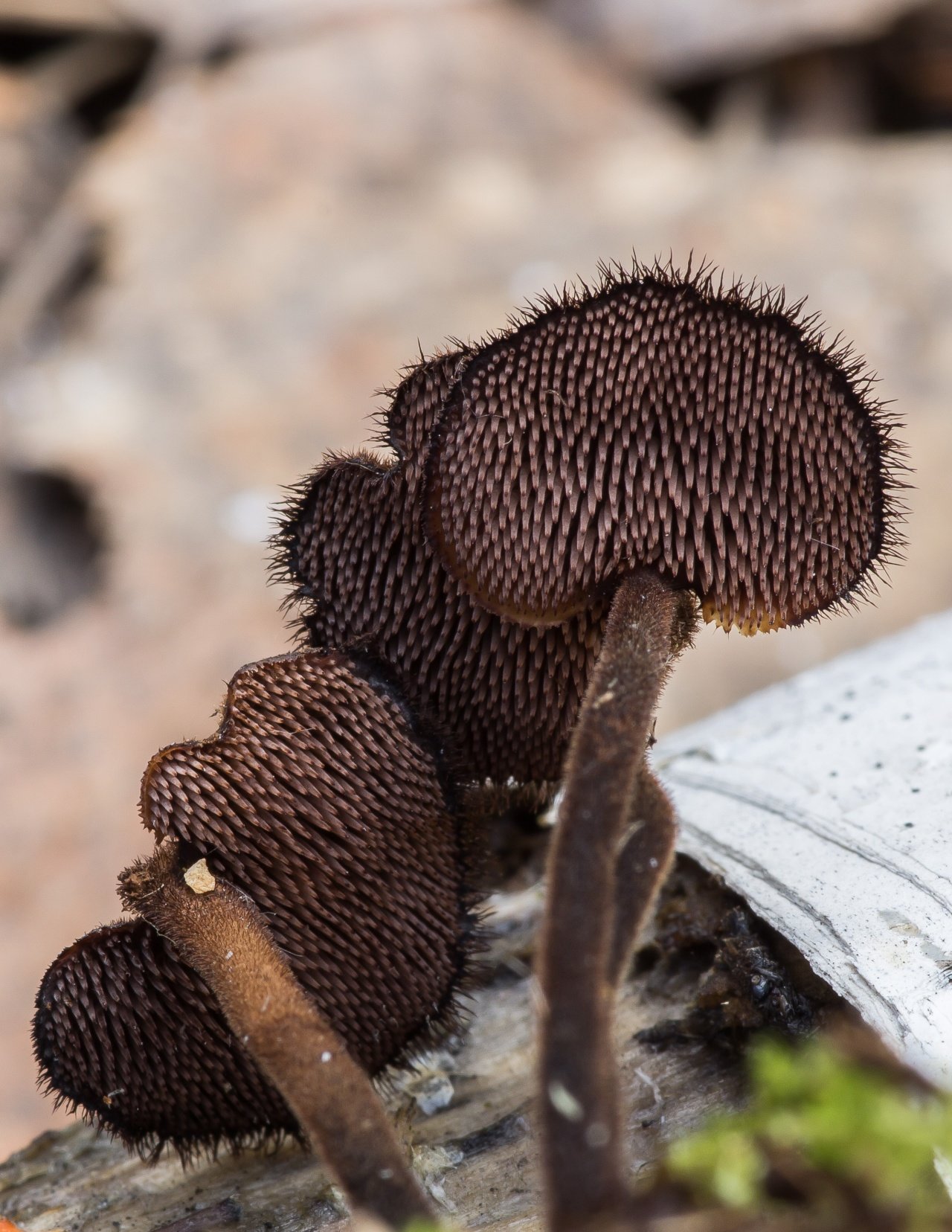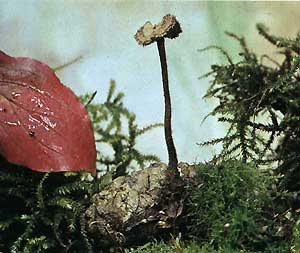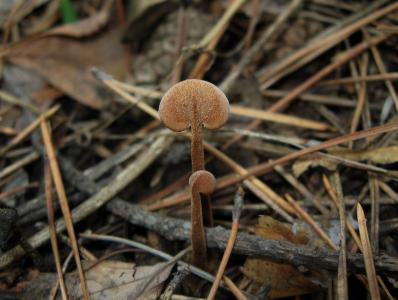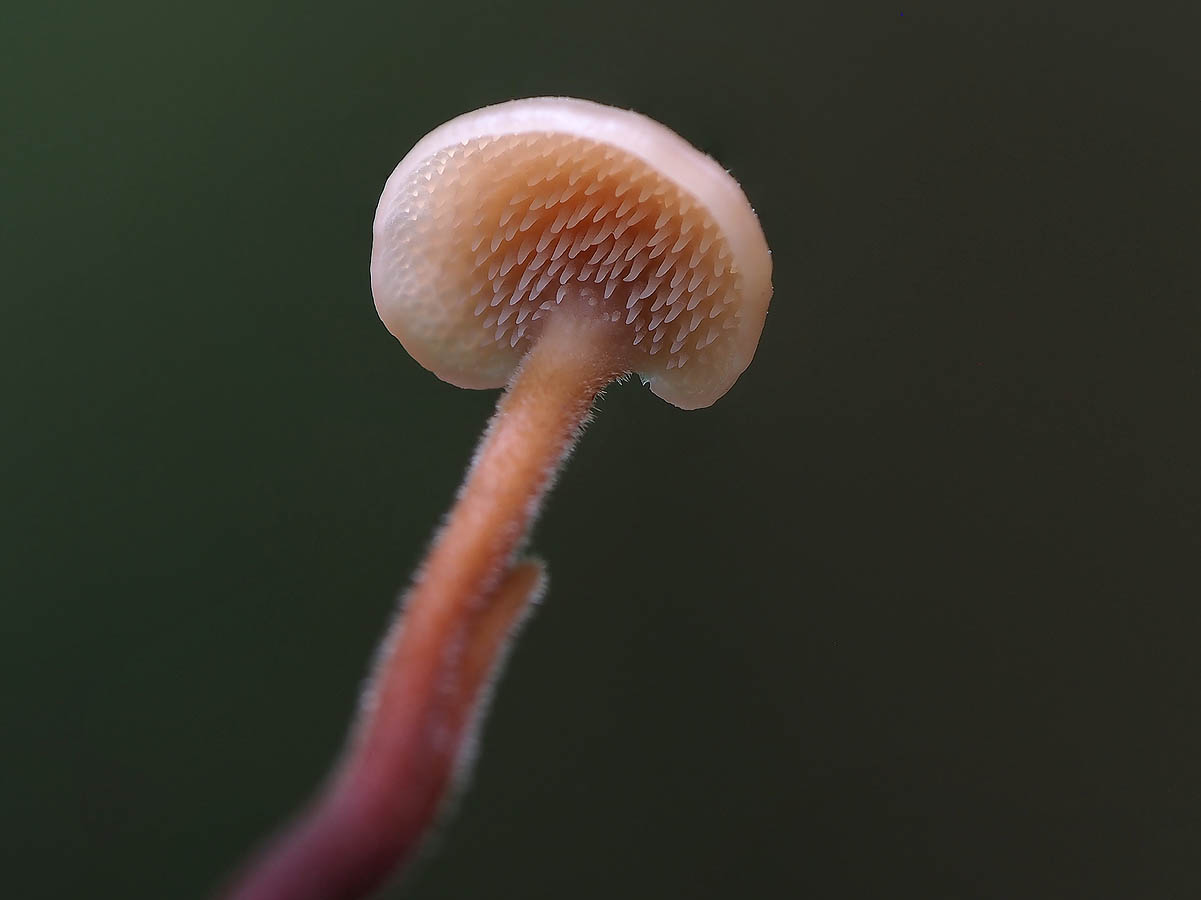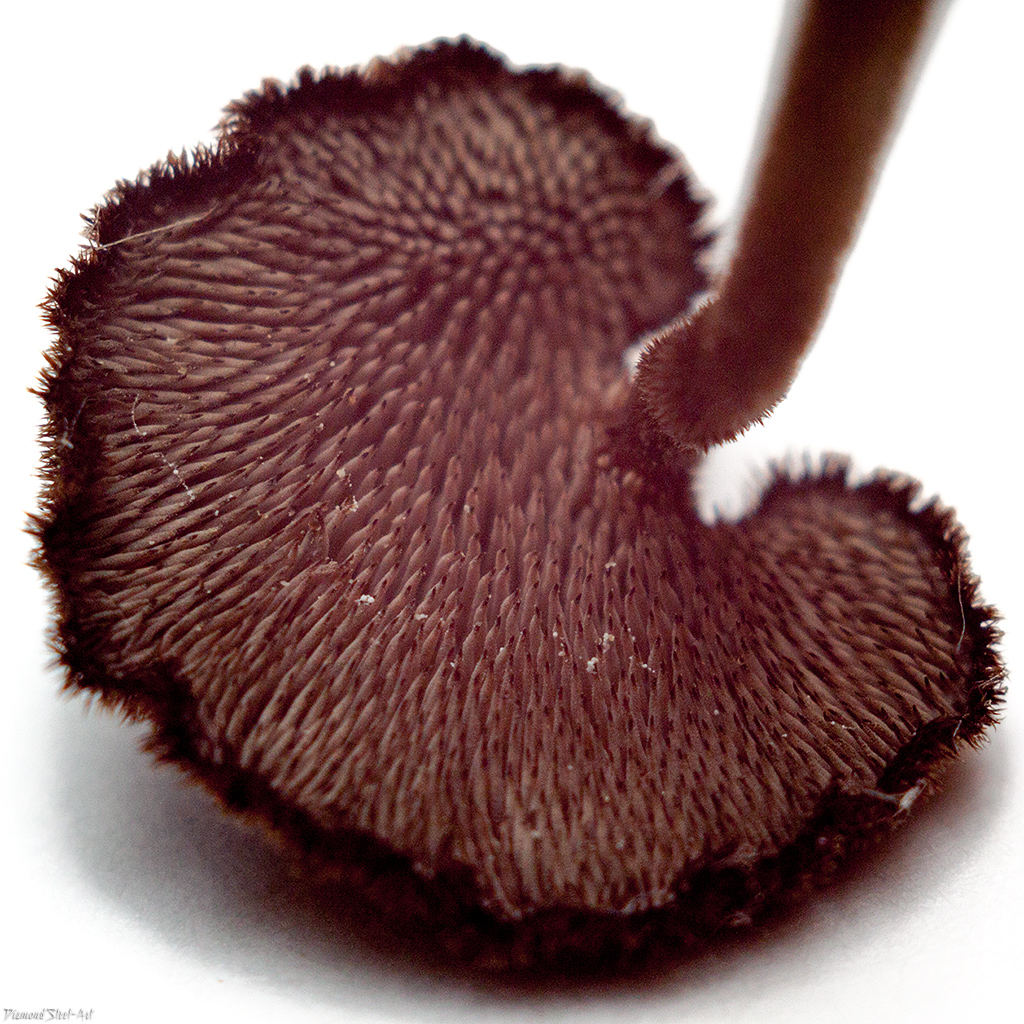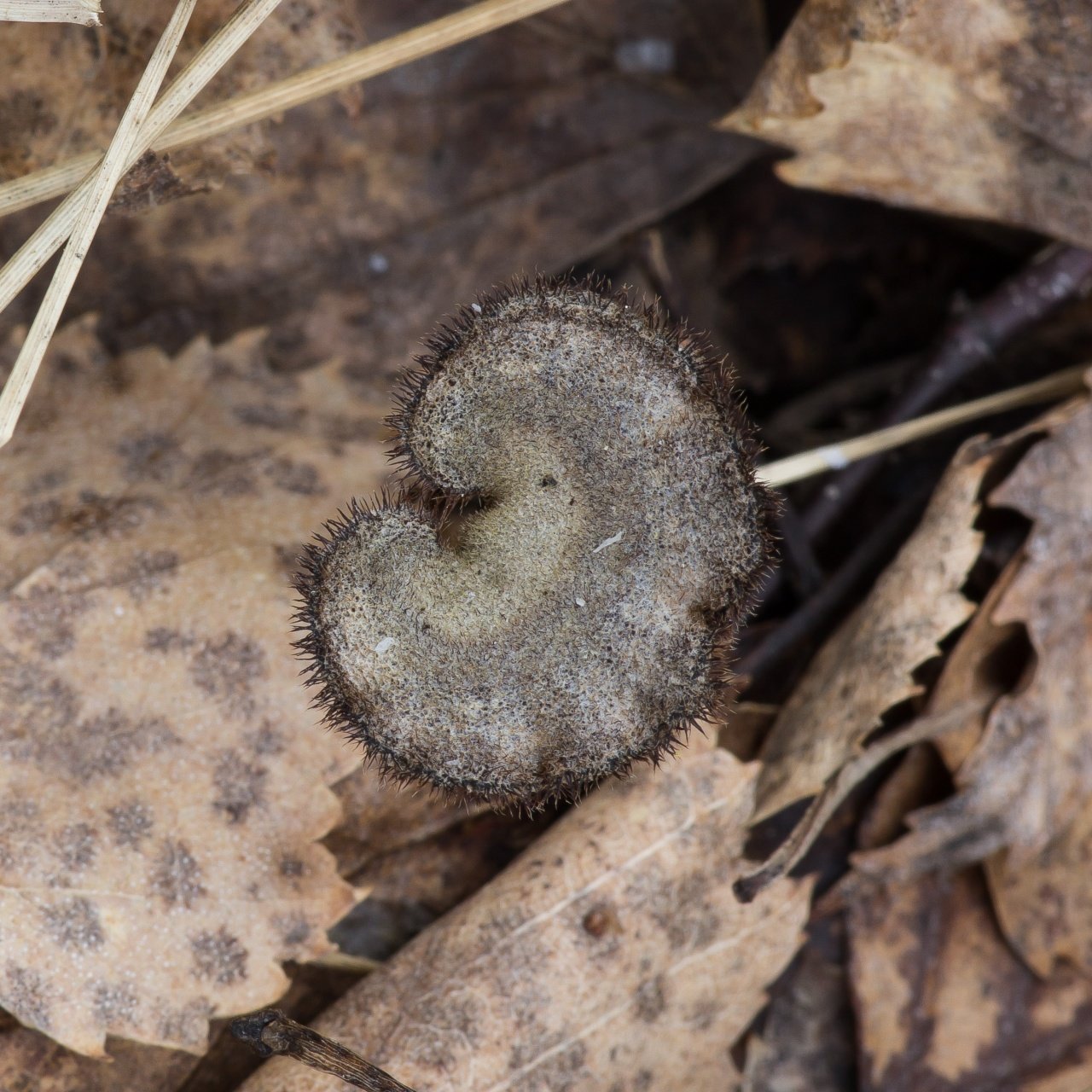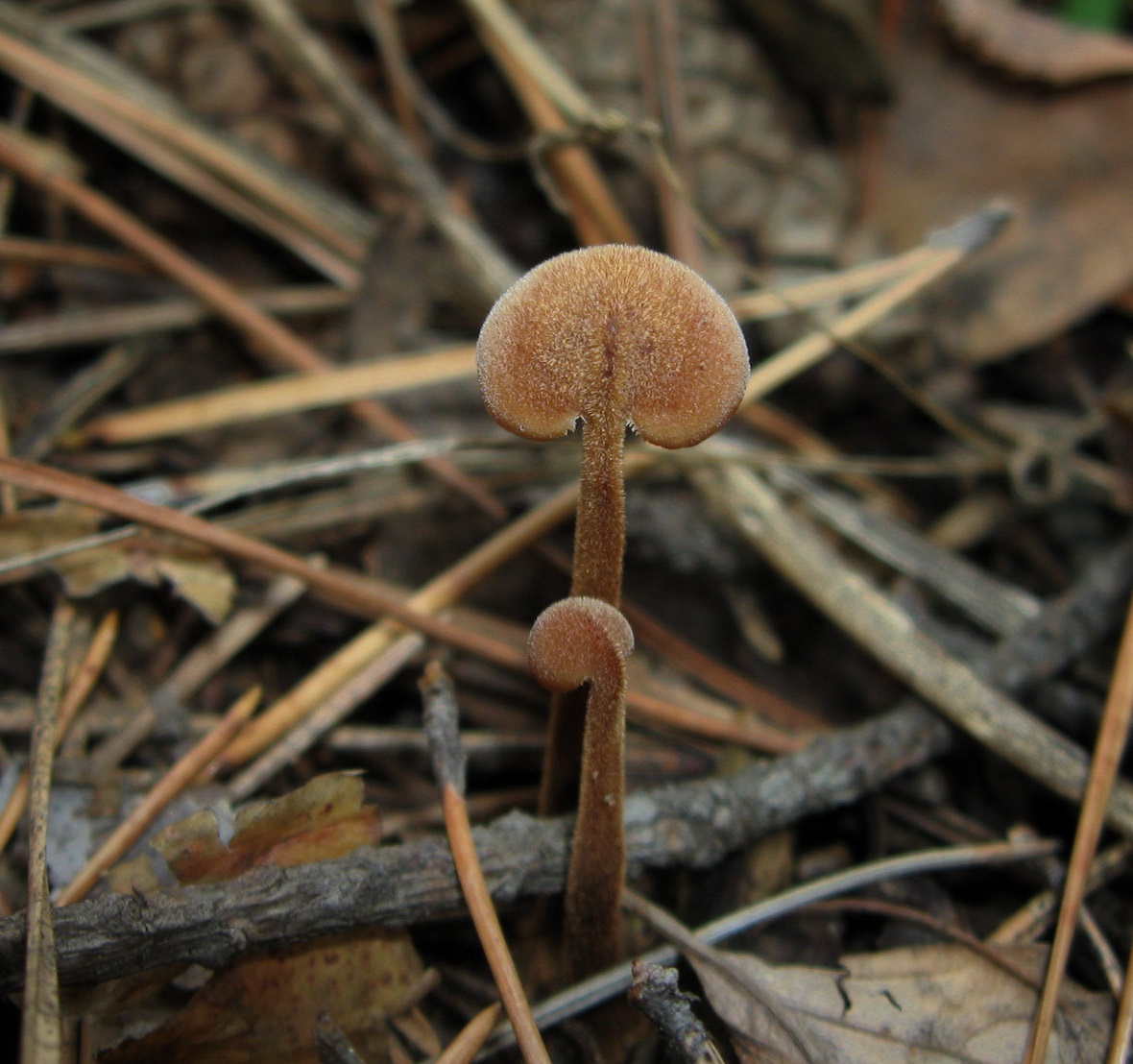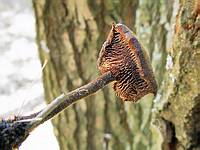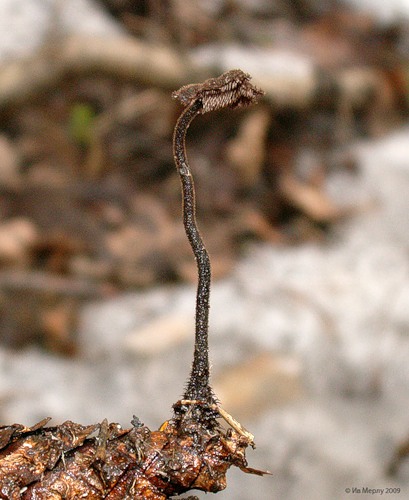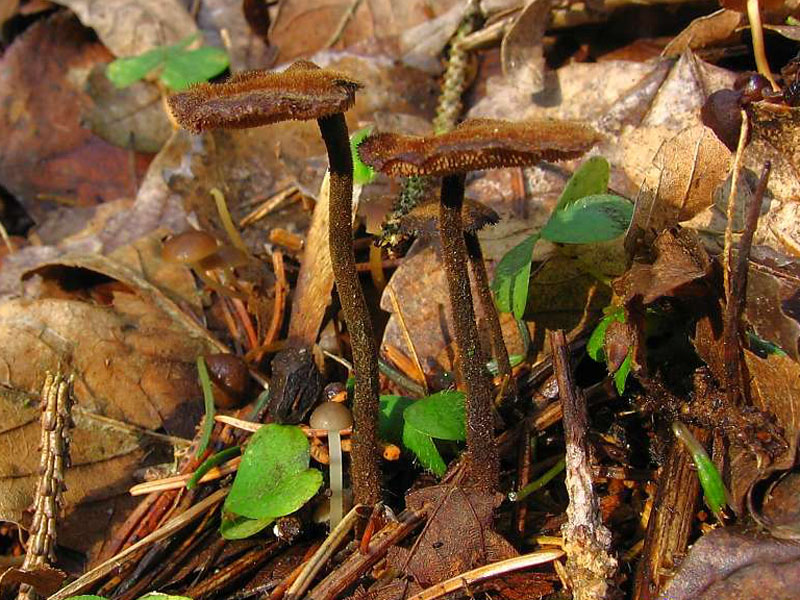Fruity body development
The fruiting body of primordia first appears between the scales of the cones and requires 9 to 35 days to reach its final height. They consist of an inner core of a thin-walled progenitor hyphae, attached by an outer coat of skeletal hyphae. The immature fruit bodies are white and thin, but gradually turn brown as they mature. As the cap is grown from the stem tip after it bends, the cap breaks stem growth and this change to centrifugal growth (ie, outward growth from the stem) results in a typical kidney-shaped or semi-circular cap. Although the fruity body takes at least 9 days to mature, spore production begins within 48–72 hours after the cap begins to grow. The spines begin as shallow bulges on the side of the base adjacent to the undersurface of the cap. As the cap increases, these spines spread horizontally and more bulges are formed that extend vertically downward.
When grown under favorable conditions of high water and moisture availability, the fruiting body can expand, growing additional (secondary) fruit bodies on all parts of its upper and lower surfaces. This secondary growth is usually a number between four and seven; some may be aborted as nutrients from the base of the pinecone are depleted, resulting in stems lacking caps. In one case, a complete secondary proliferation was noted (i.e., growing from the primary proliferation), which developed fully to produce viable spores. Moisture is the limiting factor for optimal fruity body development. Removing incompletely mature laboratory-grown specimens from relative humidity (R.H). from over 98% to one in 65-75% causes the fruit bodies to brown and stop growth. When transferred to an even lower R.H. about 50%, the foundations quickly begin to deteriorate. Light also affects the fruity development of the body: both continuous illumination and total darkness inhibit growth.
When the stem develops, the fungus is negatively geotropic, so that if the stem's axis is tilted by 90 degrees, it will return to an upright position within 24 hours. The spread of the hyphae that form the cap are themselves diageotropic - they will grow at right angles to the direction of gravity. Finally, the spines are positively geotropic and will reorient themselves to point downward if the fungal orientation changes. Because the second (cap formation) and third (spine formation) are geotropic responses overlapping, there is a brief period where two different geotropic responses work simultaneously. These geotropic transitions help ensure that the final alignment results in optimal spore dispersion.
History, taxonomy and phylogeny
The species was first described in the scientific literature by Karl Linnaeus under the name Hydnum auriscalpium in its 1,753 Varieties of Plantarum... Linnaeus placed three other dental fungi in the genus Hydnum: H. imbricatum, H. repandum and H. tomentosum... In 1821, Samuel Frederick Gray believed that H. auriscalpium was quite different from other varieties Hydnumto guarantee the creation of a new kind, Auriscalpiumto contain it. In the process, its name was changed to Auriscalpium vulgare.
Otto Kunz and Howard James Banker later independently sought to reconstruct the name of the Linnaeus species, but the resulting combination (Auriscalpium auriscalpium) is a tautonym and rejected under the rules for botanical nomenclature (ICBN rule 23.4 of 2005) and these combinations are therefore no longer legally issued. Other names given to the mushroom and now considered synonymous include Hydnum fechtnerinamed by Joseph Velenowski in 1922 and later combinations based on this name. A. vulgare - species such as the widely distributed genus of the eight species to which it belongs.
Despite significant differences in appearance and morphology, A. vulgare related to taxa as diverse as gilled mushrooms Lentinus, poroid genus Albatrelluslike coral Clavicorona and supportive dental fungus Hericium... The relationships of all these taxa - members of the Auriscalpiaceae family of the order Russulales - have been demonstrated through molecular phylogenetics.
Auriscalpium vulgare commonly known as "pinecone mushroom", "cone tooth", "pinecone tooth" or "ear picking mushroom". Gray called it the "common earpick stool"; it was also referred to as the "Hydnum fir-cone" when it was still considered to be a member of that genus. A definite epithet vulgare means "common". Generic name Auriscalpium Latin for "ear picking" and refers to a small, scoop-shaped instrument used to remove foreign matter from the ear.
Growth in culture
Auriscalpium vulgare can be grown in pure culture on agar-containing plates added with nutrients. The colonies that grow are white to enclose the cream and cover the agar surface within six weeks of the initial grafting. The mycelium is made of bent hyphae without any hyphae antenna (hyphae that extend above the surface of the agar). Typically, two obscure zones develop approximately 6 mm and 15 mm from the initial graft spot, with each zone approximately 4 mm wide. The zones appear somewhat lighter in color because the hyphae are more densely packed and form transparent substances that are applied to the agar.
Mature mycelium consists of thin-walled, densely packed hyphae that are 1.5–3.2 µm in diameter. They often become knobby or somewhat subhelicoid, and often branched at an angle of approximately 45 ° with a clip at the base of the branch. They contain amorphous granules that appear refractive when viewed under phase contrast microscopy, and their walls are often encrusted with tiny granules. Gloeocystidia (thin-walled cystidia with a refractive, often granular content) are common; they measure 50–85 by 6.5–8.5 µm, and are club-shaped (sometimes elongated), thin-walled, and often have one or two lobes with rounded tips. Containing a frothy and pale yellow content, they are refractive yellow under phase contrast. They are initially upright, but they soon fall under their own weight to lie on the agar surface. Transparent deposits are abundant as small, randomly scattered lamellar or star-shaped crystals.
Fruiting begins about six weeks after the initial grafting on the agar plate, but only when parts of the fruit bodies (spines or stem sections) are used as grafting material to start growth; the use of mycelium as a grafting material eliminates subsequent fruiting. Mature fruit bodies grow very close to the initial grafting site - within 3 mm - and take about 60 days to mature after they first begin to form.
Red Book
Are you here:
Home - Red Data Book of the Amur Region - Auriskalpium ordinary
Auriskalpium ordinary
Family Auriscalpiaceae - Auriscalpiaceae
Auriskalpium ordinary - Auriscalpium vulgare Gray
Category and status .. 2 а. A vulnerable species that is declining in numbers as a result of changes in conditions of existence or destruction of habitats.
A brief description of. In the Amur Region, Auriskalpium ordinary was recorded in the Khingansky Nature Reserve, Zeysky Nature Reserve, Magdagachinsky District (station Tygda), in the vicinity of Blagoveshchensk (1, 2, 3, 4). In Russia - the European part, the Caucasus, Siberia, the Far East.General distribution - Europe, North America, Central and East Asia.
A brief description of. The fruiting bodies consist of a cap and a stem. The cap is 1-2 cm in diameter, semicircular or kidney-shaped, more often eccentric or lateral, thin, convex, sometimes with a tubercle, with a drooping or overhanging edge, hard-fleecy, with protruding hairs over the entire surface, with a shaggy fleecy edge,
brownish, gray-brown, brown, in wet weather black-brown, sometimes zonal-colored from the red-brown middle to the light edge. Hymenophore with conical spines of regular shape 0.1-0.3 cm long, at first brownish-brown, with the formation of spores - lighter with a grayish bloom. Spore powder is gray.
The pulp is thin, tough, rubbery, odorless. The stem is long and thin, up to 10 cm long and 0.1-0.3 cm in diameter, even or curved, bristly tomentose, dark brown, usually darker than the cap. At the base, entangled hyphae are connected to the substrate (5).
Features of ecology and phytocenology. It uses coniferous cones, usually pine, as a substrate. Fruit bodies are formed from spring to late autumn. Found in coniferous and mixed forests.
Limiting factors. Degradation of conifers
forests as a result of fires, as well as human economic activity.
Security measures taken. Protected in the Zeysky and Khingansky reserves.
Necessary security measures. Conservation of natural habitats, search for new locations of the species, their protection and monitoring.
Sources of information. 1. Azbukina et al., 1998; 2. Flora and vegetation ..., 1981; 3. Vasilyeva, Nazarova, 1962; 4. Data of the originator; 5. Nikolaeva, 1961. Compiled by. ON. Kochunov.
|
20.10.2015 20:25:13
Back forward
-
Menu
- home
- Photo gallery
-
Animals
- Mammals
- Birds
- Fishes
- Amphibians
- Reptiles
- Insects
- Crustaceans
- Worms
- Molluscs
-
Plants
- Angiosperms
- Gymnosperms
- Ferns
- Mosses
- Seaweed
- Lichens
- Mushrooms
- Moscow
-
Moscow region
- Mammals
- Birds
- Invertebrates
- Pisces, presm., Terrestrial.
- Plants
- Mushrooms, mosses, lichens
-
Voronezh region
- Plants
- Animals
-
Republic of Crimea
- Plants
- Animals
-
Rostov region
- Plants
- Animals
-
Krasnodar Territory
- Plants
- Animals
-
Leningrad region
- Plants
- Animals
-
Pskov region
- Plants
- Animals
-
Sverdlovsk region
- Plants
- Animals
-
Saratov region
- Mushrooms
- Bryophytes
- Ferns
- Amur region
- Krasnoyarsk Territory
- Belgorod region
-
Chelyabinsk region
- Plants
- Animals
-
IUCN Red List
- Extinct mammals
- Rare birds of the world
- Cetaceans
- Carnivores
- Reserves of Russia
- Wild animals
- Birds of Russia
- Download the Red Book
- Basic documents
- Custom sog.
- .
Habitat and distribution
Auriscalpium vulgare Is a saprobic species. Its mushrooms become solitary or clustered on fallen pine cones, especially those that are fully or partially buried. It tends to favor Scots pine. (Pinus sylvestris)but it has also been reported of stylish cones, and in California grows primarily on pseudo-cones. One author noted the presence of a fungus on elegant needles on top of a squirrel den, where cone bracts were present in the grass cover. In a study in the area of Leojong Mountain, Yunnan Province, China, A. vulgarehas been found to be one of the most dominant species collected from the mixed forest in height. Investigation of the cut effect and burn methods in northeastern India showed that the mushroom prefers to bear fruit on Hazi Pine's burnt cones, and that the number of fruit bodies on unburnt cones increases with the circumference of the cone.
The mushroom is widely distributed in Europe, Central and North America, temperate Asia and Turkey. In North America, its range extends from Canada to the Trans-Mexican Volcanic Belt south of Mexico City.The fungus is common, appearing in summer and autumn, although it is easily overlooked due to its small size and indescribable coloration. A. vulgare - the only representative of its kind in the temperate regions of the northern hemisphere.



